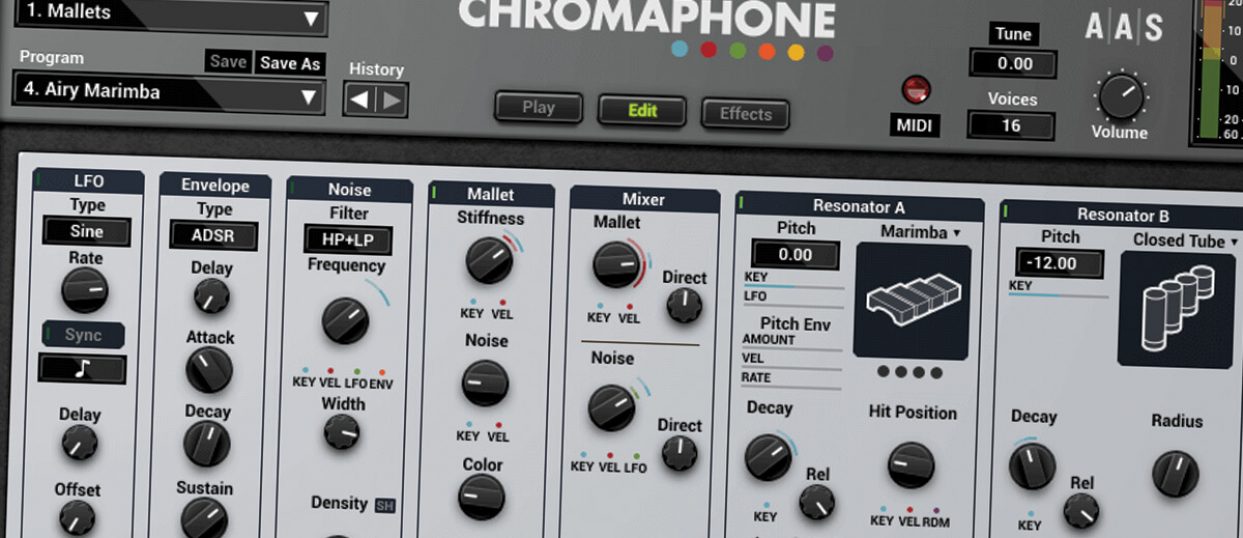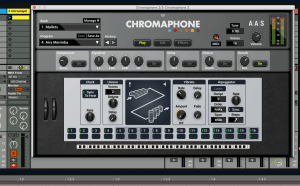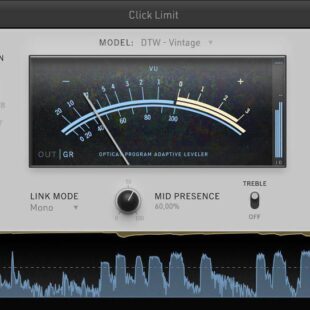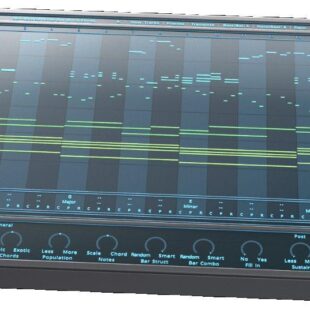Applied Acoustic Systems Chromophore 2 – Percussive resonance
The French-Canadian acoustic modellers are at it again! You may remember AAS or Applied Acoustic Systems, from such great soft synths as the original Chromaphone 1, the amazing Lounge Lizard and the greatly underrated Tassman 4 modular system!
Words by Ian V Jones
The guys that run the company are two doctors of Acoustics, so as you might imagine there are two colossal brains behind the Chromophore 2. And they’ve used them to create a very compelling tuned percussion instrument.
What is Chromophore you might ask? Well in simple terms it is modelling the sound of acoustic percussion using as much math and programming as the Canadian eggheads can muster, predominantly of the tuned variety, like chimes, bells, marimbas, tom toms and just about anything else that can be hit. That’s not to say it only explores the realms of percussion; it also uses its modelling powers to create basses, keys, pads, soundscapes and just about anything else you can think of!
So how does all this audio wizardry manifest itself within Chromohone 2?
Let’s delve in a take a look. The way that Chromaphone 2 achieves these percussive feats is to replicate that initial striking action in the “Noise” module and the “Mallet” module, and then have it resonated by a series of different “Resonators”. These can be a number of different emulations ranging from a string to beams (Tines I guess is what these might be if you are familiar with a Rhodes keyboard). All the way through to membranes, plates, marimba, drum heads and closed tubes, which when pitched up slightly sound very much like that “Ear Worm” tune “Popcorn” by Gershon Kingsley.
Good luck getting that out of your head once it’s in there!!
Now this isn’t just a sound design black hole where you will fall endlessly as you try and create that new sound nobody has ever heard before, this can be a simple sound machine.
If all you want to do is find a usable Marimba sound or do a 2016 remix for “Popcorn” (Is it back in your head again?), then a quick flick through the extensive preset library will easily cover all your bases. But in true modern-day soft synth fashion, you can go on a sound design crusade should the urge come over you! Each Resonator can be manipulated quite extensively with the 10 or so options available to you. Pitch, key, hit position, Tone, Material type plus decay and release options.
Now I would like to point out a few GUI design issues I have. Firstly, there’s no real consistency with the control panels. You have easily recognisable knobs for some of the functions and then fiddly slider controls for others. Just tiny thin lines that you have to aim at with your mouse. Not impossible to get my head around but nonetheless annoying.
One other thing that had me confused was the tiny “on-off” button ( or lack of a button ) for each of the resonators and other modules with the Plug-in. You click the top left of each module and a tiny green light will appear letting you know that the module is in fact activated. I’m down with being minimalist but this had me scratching my head for a while, especially when I was trying to activate the arp. (we’ll cover that in a minute)
I mean, none of this is make-or-break, but at the same time, some consistent aesthetic would have been nice.
While I’m on the topic, I didn’t enjoy the way Chromaphone 2 looked at all. I hate to say it but in this day and age “we taste with our eyes before our ears” (Pretty sure that’s how that saying goes.)
Once I got over the “Fugliness” of Chromaphone 2 I started to love the way this thing sounded. If you want an addition to your sound design palette, then this would be worth the investment. I also hear this as a great tool for the Techno producers out there; I don’t write Techno per se’ but every single time I played anything on it I invariably was inclined to write a deep brooding Techno classic!!
Chromaphone 2 also come with the usual complement of LFOs and Vibrato, essential for adding the necessary variables for the replication of acoustic instruments. Also, there’s a flexible ARP thrown in for good measure.
I’ll be honest and say that due to the On/Off switch eluding me the first few times I opened the Plug-in, I didn’t get to delve too deeply into all of its functions. I do think that with this kind of Plug-in, the ARP is essential and I was more than happy with the way it functioned. Once again though a more “User-Friendly” GUI would have gotten me more excited about digging deeper into it.
Now tagged onto the end of this sonically beautiful instrument is a set of the usual type of effects Low Pass Filter, Delay Reverb, etc. that I wasn’t really that excited by much. And if I was to be brutal about it, I would have to say that using the Plug-in onboard EFX did nothing really to enhance the sounds, and in a lot of cases made them sound cheap. The Reverb especially.
Look I know that we all expect a thousand and one “Bells and Whistles” with everything we buy, but I kinda wish this Chromaphone 2 was an unapologetic acoustic sound modeller and nothing else. Its skills in this area are exemplary, and even though the arp was useful, leaving that and the effects section off would have made me feel like this was a “Pro” tool in my sonic arsenal.
Conclusions
So in conclusion – would I buy Chromaphone 2?
Yes, in a heartbeat. No matter how annoying the GUI and the Effect section is, you just can’t argue with how good this thing sounds and how many options you have at your disposal for creating tuned percussion and an array of acoustically modelled sounds.
This is definitely a “Brains over Beauty” type love affair with Chromaphone 2
Chromaphone 2 $199 USD








